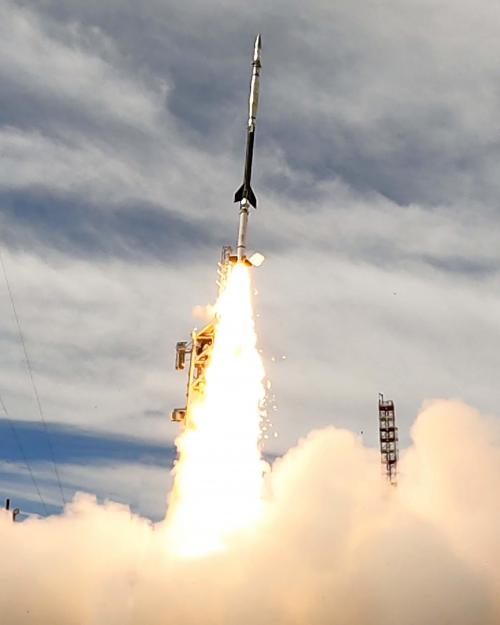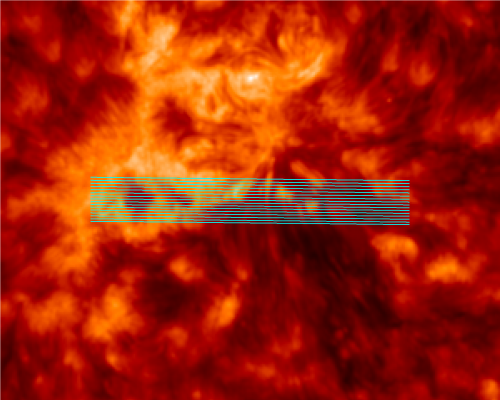Successful launch of the solar sounding rocket CLASP2.1
 Image. A launch of sounding rocket carring CLASP2.1 payload (Credit: US Army Photo, White Sands Missile Range)
Image. A launch of sounding rocket carring CLASP2.1 payload (Credit: US Army Photo, White Sands Missile Range)
The CLASP2.1 (Chromospheric LAyer Spectro-Polarimeter 2.1) solar sounding rocket was successfully launched at the White Sands Missile Range on October 8, 2021 at 11:40 in Mountain Daylight Time, USA (October 9, 2021 at 02:40 in Japan). Both the launch vehicle and the instruments worked perfectly and successfully acquired observation data for about 6 minutes.
Solar chromosphere observed by the CLASP2.1 slit-jaw monitor system. We obtained UV spectra at 16 locations shown by blues lines (Credit: NAOJ, NASA, IAS, IAC).
The area observed by CLASP2.1 on the Sun. In the left panel, a white square shows the field of view of the CLASP2.1 slit-jaw monitor system (lower right panel) on a full disk image of the solar chromosphere taken by the SDO/AIA. Upper right panel shows the enlarged SDO/AIA image. (Click on the image to view a gif movie. A mp4 movie file is here.)
The CLASP2.1 is a re-flight of the sounding rocket experiment CLASP2 conducted in 2019, which revealed the height variation of the magnetic field from the bottom of the chromosphere to the top of the chromosphere by measuring the polarization of ultraviolet radiation emitted from the solar chromosphere. However, since the observation was performed with a fixed slit, only one-dimensional magnetic field information in space along the slit was obtained. This time, CLASP2.1 aims to obtain a 3-dimensional (2-dimensional space + height) magnetic field map by moving the slit step by step.
The CLASP2 payload, which had been recovered after launch and stored at NASA's Marshall Space Flight Center, was brought to the White Sands Missile Range at the end of August 2021. Despite the severe conditions caused by the COVID-19 pandemic, Japanese principal investigator Ryohko Ishikawa and instrument scientist Donguk Song (who moved from the National Astronomical Observatory of Japan to Korea Astronomy and Space Science Institute in this August) participated in the month-and-a-half-long test and witnessed the first launch in two and a half years.
During the launch, we also conducted coordinated observations with Hinode and other satellites and acquired observation data of the photosphere and corona at the same time. Please look forward to the future results.
[Related link]
The sounding rocket experiment CLASP2.1 is an international collaboration led by NASA/Marshal Space Flight Center (USA), NAOJ, Instituto de Astrofísica de Canarias (Spain), and Institut D'Astrophysique Spatiale (France). The details can be found at;
CLASP2 web site: https://solarwww.mtk.nao.ac.jp/Rocket_balloon_experiments/CLASP2/index_e.html
CLASP2 result: https://hinode.nao.ac.jp/en/news/results/clasp2-publication-en-202102/
Sounding Rocket Mission to Offer Snapshot of Sun's Magnetic Field (NASA):https://www.nasa.gov/feature/goddard/2021/sounding-rocket-mission-to-offer-snapshot-of-sun-s-magnetic-field/
CLASP2.1: a new suborbital space mission for mapping the magnrtic field of the solar chromosphere (IAC):https://www.iac.es/en/outreach/news/clasp21-new-suborbital-space-mission-mapping-magnetic-field-solar-chromosphere
Regarding the use of images and movies on the page concerned, please visit the page here. The credits of images and movies on this page are “NAOJ/JAXA” unless explicitly stated to the contrary. Regarding images and movies on this page the credits of which are “NAOJ/JAXA”, "NAOJ/JAXA/MSU", or “NAOJ, JAXA, NASA/MSFC”, terms of use for Copyrighted Works owned by NAOJ can be applied. In using the images and movies, the credits should be given.


